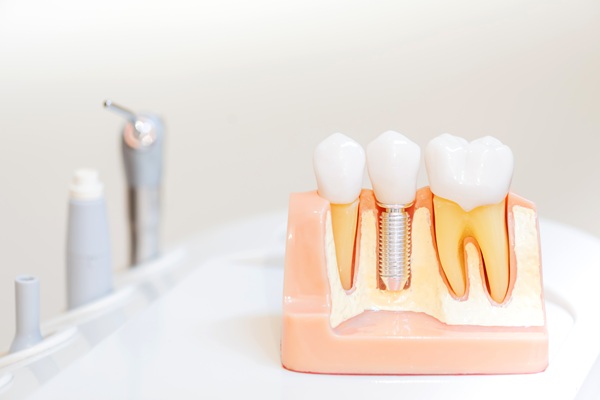Bone Graft Procedure Prior to Dental Implant Placement

Bone graft surgery becomes necessary when a person lacks enough bone mass to hold a dental implant in place. So, why do some patients have insufficient bone tissue? The jawbone regenerates when stimulated by a natural tooth, which happens whenever a person bites down. When the person loses the tooth, there is nothing left to stimulate that particular area of the jawbone. The bone atrophies, losing both mass and density. In the end, the bone becomes too narrow and thin to hold an implant.
How a dental implant should sit in the jawbone
A dental implant embeds in the jawbone, where it plays the role of a tooth root. Once the implant integrates with the jaw, it is stable enough to anchor a dental restoration like a crown or a set of dentures. However, a dentist must ensure that the implant is surrounded by bone on all sides except the top.
The implant must sit on bone, without getting too close to underlying nerves. It should also be positioned slightly below the top surface of the jawbone. As a rule of thumb, the implant should be surrounded by bone that is one millimeter thick. If a patient lacks enough bone to meet these requirements, a dentist will recommend a bone graft.
Bone graft surgery, in a nutshell
A successful bone graft increases the amount of bone in the jaw, at the site of the missing tooth. During the procedure, a dental professional will administer anesthetic to the patient. Sometimes the dentist will use bone from another part of the patient’s body, usually the tibia, hip or jaw. To harvest the bone, the dentist will need to put the patient to sleep. The dental professional may also need another type of surgeon to harvest the bone.
Because of the morbidity of two surgical sites, many dentists and patients choose the following options:
- Donor bone from another human being
- Donor bone from a non-human animal
- Synthetic, biocompatible material that can fuse with bone tissue
Irrespective of where the donor bone tissue comes from, the dentist will proceed to open up the gums at the site of the missing tooth. This will expose the bone. The dentist will then place the donor material in the jaw and suture the gums shut. The patient will go home and wait for the donor bone to integrate with the jaw. This can take up to three months.
The timing of bone graft surgery in relation to implant placement
Often, bone graft surgery is done weeks or months before dental implant placement. This gives the donor bone time to fuse with the jawbone. The dentist will wait just long enough for the donor bone to integrate, but not too long that the jaw begins to lose mass again.
In some situations, the dentist will perform bone graft surgery and place an implant in a single procedure. They will only do this when operating on a small area. A patient who gets this two-in-one procedure should be in excellent health, with the ability to follow instructions for post-operative care, to the letter. Most dentists prefer to perform a bone graft separately from implant placement, simply to minimize the chances of implant failure.
Are you ready to restore your smile?
A full set of teeth is good for your self-esteem and great for your oral health. Get in touch with your dentist to schedule a consultation. After doing a thorough evaluation of your physical and oral health, the dentist will advise you on whether or not you need bone graft surgery.
Request an appointment here: https://spectrumsurgical.net or call Facial Spectrum at (816) 524-4334 for an appointment in our Lee's Summit office.
Check out what others are saying about our services on Yelp: Read our Yelp reviews.
Recent Posts
Dental implants represent a durable and aesthetically pleasing solution for replacing missing teeth. Understanding the proper care for dental implants remains essential to ensure longevity and optimal function. Adhering to recommended practices significantly reduces the risk of complications, preserves oral health, and maintains the attractive appearance and comfort associated with implants. By implementing consistent maintenance…
The jawbone is the part of the face that holds many essential elements together, such as the teeth, ligaments, and muscles; however, bone grafting may sometimes be necessary if the jawbone is too weak to perform these tasks. A person’s jawbone can deteriorate over time, whether due to age, genetics, poor oral health, cancer, or…
Finding lasting relief from issues such as misalignment and facial asymmetry can involve specialized procedures. Fortunately, corrective jaw surgery is a reliable option for addressing these concerns. A dental specialist realigns the upper or lower jaw during this process to promote better function and comfort. Although the procedure can benefit health and appearance significantly, a…
Many individuals seek rhinoplasty to enhance facial harmony, improve nasal function, or correct structural abnormalities. As a surgical procedure that reshapes the nose, rhinoplasty can address aesthetic concerns as well as breathing difficulties caused by structural defects such as a deviated septum. Understanding the consultation process, surgical techniques, and what to expect from the recovery…


